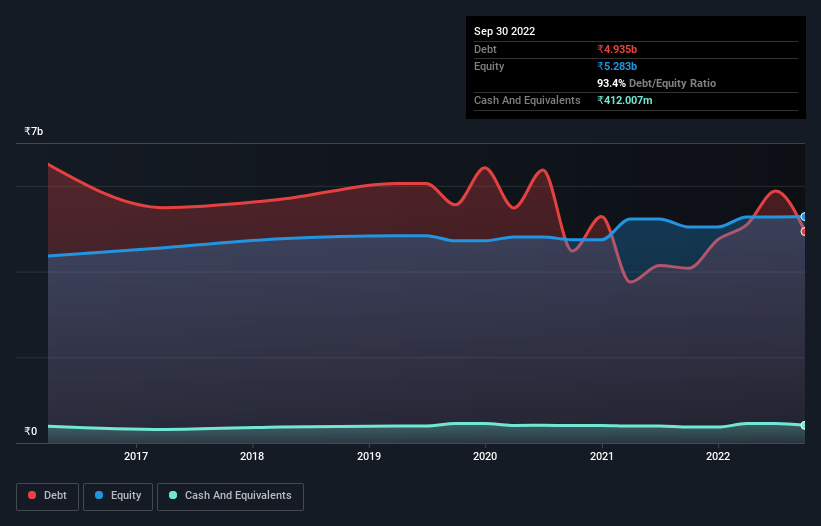- India
- /
- Specialty Stores
- /
- NSEI:TBZ
Tribhovandas Bhimji Zaveri (NSE:TBZ) Use Of Debt Could Be Considered Risky
Legendary fund manager Li Lu (who Charlie Munger backed) once said, 'The biggest investment risk is not the volatility of prices, but whether you will suffer a permanent loss of capital.' It's only natural to consider a company's balance sheet when you examine how risky it is, since debt is often involved when a business collapses. We can see that Tribhovandas Bhimji Zaveri Limited (NSE:TBZ) does use debt in its business. But should shareholders be worried about its use of debt?
When Is Debt Dangerous?
Debt and other liabilities become risky for a business when it cannot easily fulfill those obligations, either with free cash flow or by raising capital at an attractive price. In the worst case scenario, a company can go bankrupt if it cannot pay its creditors. While that is not too common, we often do see indebted companies permanently diluting shareholders because lenders force them to raise capital at a distressed price. Of course, the upside of debt is that it often represents cheap capital, especially when it replaces dilution in a company with the ability to reinvest at high rates of return. The first thing to do when considering how much debt a business uses is to look at its cash and debt together.
Check out our latest analysis for Tribhovandas Bhimji Zaveri
What Is Tribhovandas Bhimji Zaveri's Net Debt?
As you can see below, at the end of September 2022, Tribhovandas Bhimji Zaveri had ₹4.94b of debt, up from ₹4.08b a year ago. Click the image for more detail. On the flip side, it has ₹412.0m in cash leading to net debt of about ₹4.52b.

How Healthy Is Tribhovandas Bhimji Zaveri's Balance Sheet?
The latest balance sheet data shows that Tribhovandas Bhimji Zaveri had liabilities of ₹8.62b due within a year, and liabilities of ₹663.9m falling due after that. Offsetting these obligations, it had cash of ₹412.0m as well as receivables valued at ₹39.3m due within 12 months. So its liabilities outweigh the sum of its cash and (near-term) receivables by ₹8.83b.
The deficiency here weighs heavily on the ₹4.42b company itself, as if a child were struggling under the weight of an enormous back-pack full of books, his sports gear, and a trumpet. So we'd watch its balance sheet closely, without a doubt. After all, Tribhovandas Bhimji Zaveri would likely require a major re-capitalisation if it had to pay its creditors today.
In order to size up a company's debt relative to its earnings, we calculate its net debt divided by its earnings before interest, tax, depreciation, and amortization (EBITDA) and its earnings before interest and tax (EBIT) divided by its interest expense (its interest cover). This way, we consider both the absolute quantum of the debt, as well as the interest rates paid on it.
Weak interest cover of 2.1 times and a disturbingly high net debt to EBITDA ratio of 5.5 hit our confidence in Tribhovandas Bhimji Zaveri like a one-two punch to the gut. This means we'd consider it to have a heavy debt load. Investors should also be troubled by the fact that Tribhovandas Bhimji Zaveri saw its EBIT drop by 16% over the last twelve months. If things keep going like that, handling the debt will about as easy as bundling an angry house cat into its travel box. The balance sheet is clearly the area to focus on when you are analysing debt. But you can't view debt in total isolation; since Tribhovandas Bhimji Zaveri will need earnings to service that debt. So when considering debt, it's definitely worth looking at the earnings trend. Click here for an interactive snapshot.
But our final consideration is also important, because a company cannot pay debt with paper profits; it needs cold hard cash. So it's worth checking how much of that EBIT is backed by free cash flow. Over the last three years, Tribhovandas Bhimji Zaveri actually produced more free cash flow than EBIT. That sort of strong cash generation warms our hearts like a puppy in a bumblebee suit.
Our View
On the face of it, Tribhovandas Bhimji Zaveri's net debt to EBITDA left us tentative about the stock, and its level of total liabilities was no more enticing than the one empty restaurant on the busiest night of the year. But on the bright side, its conversion of EBIT to free cash flow is a good sign, and makes us more optimistic. We're quite clear that we consider Tribhovandas Bhimji Zaveri to be really rather risky, as a result of its balance sheet health. So we're almost as wary of this stock as a hungry kitten is about falling into its owner's fish pond: once bitten, twice shy, as they say. There's no doubt that we learn most about debt from the balance sheet. However, not all investment risk resides within the balance sheet - far from it. Case in point: We've spotted 4 warning signs for Tribhovandas Bhimji Zaveri you should be aware of, and 1 of them is concerning.
At the end of the day, it's often better to focus on companies that are free from net debt. You can access our special list of such companies (all with a track record of profit growth). It's free.
Valuation is complex, but we're here to simplify it.
Discover if Tribhovandas Bhimji Zaveri might be undervalued or overvalued with our detailed analysis, featuring fair value estimates, potential risks, dividends, insider trades, and its financial condition.
Access Free AnalysisHave feedback on this article? Concerned about the content? Get in touch with us directly. Alternatively, email editorial-team (at) simplywallst.com.
This article by Simply Wall St is general in nature. We provide commentary based on historical data and analyst forecasts only using an unbiased methodology and our articles are not intended to be financial advice. It does not constitute a recommendation to buy or sell any stock, and does not take account of your objectives, or your financial situation. We aim to bring you long-term focused analysis driven by fundamental data. Note that our analysis may not factor in the latest price-sensitive company announcements or qualitative material. Simply Wall St has no position in any stocks mentioned.
About NSEI:TBZ
Tribhovandas Bhimji Zaveri
Designs, manufactures, retails, and sells jewelry primarily in India.
Proven track record with mediocre balance sheet.
Similar Companies
Market Insights
Community Narratives



